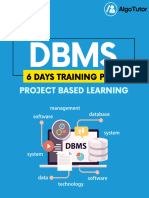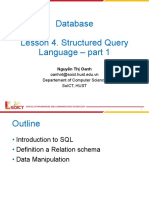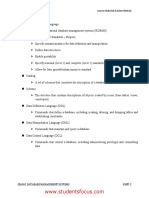0 ratings0% found this document useful (0 votes)
2 viewsSQL_Answers
The document provides an overview of SQL and database concepts, including definitions of SQL, MySQL, DDL, and DML statements. It includes example SQL queries for creating a table, inserting values, and retrieving records based on specific conditions. Additionally, it explains the differences between DELETE and DROP commands, as well as key concepts like Primary Key, Candidate Key, and Alternate Key.
Uploaded by
SOMANSH BHATIACopyright
© © All Rights Reserved
Available Formats
Download as PDF, TXT or read online on Scribd
0 ratings0% found this document useful (0 votes)
2 viewsSQL_Answers
The document provides an overview of SQL and database concepts, including definitions of SQL, MySQL, DDL, and DML statements. It includes example SQL queries for creating a table, inserting values, and retrieving records based on specific conditions. Additionally, it explains the differences between DELETE and DROP commands, as well as key concepts like Primary Key, Candidate Key, and Alternate Key.
Uploaded by
SOMANSH BHATIACopyright
© © All Rights Reserved
Available Formats
Download as PDF, TXT or read online on Scribd
You are on page 1/ 2
SQL and Database Concepts: Questions and Answers
What is SQL?
SQL (Structured Query Language) is a programming language used to manage and manipulate
relational databases.
What is MySQL?
MySQL is an open-source relational database management system (RDBMS) that uses SQL as its
query language.
What are DDL and DML statements?
- DDL (Data Definition Language): Defines and modifies database structure (CREATE, ALTER,
DROP).
- DML (Data Manipulation Language): Manipulates data in a database (INSERT, UPDATE,
DELETE).
SQL query to create a table 'students'
CREATE TABLE students (
student_id INT PRIMARY KEY,
name VARCHAR(100),
age INT
);
SQL query to insert values into 'students'
INSERT INTO students (student_id, name, age)
VALUES (1, 'John Doe', 20);
Display records of students with student_id = 30
SELECT * FROM students WHERE student_id = 30;
Difference between DELETE and DROP
- DELETE: Removes specific rows but retains the structure.
- DROP: Completely removes a table including its structure.
Explain Primary Key, Candidate Key, and Alternate Key
- Primary Key: Unique identifier for a record.
- Candidate Key: A column/set of columns that uniquely identify a record.
- Alternate Key: A candidate key not chosen as the primary key.
SQL query to display students born between 1990 and 2010
SELECT * FROM students WHERE birth_year BETWEEN 1990 AND 2010;
Display records of students with marks > 50
SELECT * FROM students WHERE marks > 50;
You might also like
- Lab 5. Databases. Introduction To SQL (CS Open CourseWare)100% (1)Lab 5. Databases. Introduction To SQL (CS Open CourseWare)11 pages
- Chapter 7 - 8: Working With Databases and SQLNo ratings yetChapter 7 - 8: Working With Databases and SQL28 pages
- Database Implementation - Structured Query Language (SQL)No ratings yetDatabase Implementation - Structured Query Language (SQL)83 pages
- Lesson Plan (Class 12information Technology)100% (2)Lesson Plan (Class 12information Technology)6 pages
- Lesson05-Creating and Modifying Database SchemaNo ratings yetLesson05-Creating and Modifying Database Schema3 pages
- Tructured Uery Anguage: Path From Unorganized To OrganizedNo ratings yetTructured Uery Anguage: Path From Unorganized To Organized10 pages
- EContent_2_2024_08_22_19_20_19_DBMSLABMANUALpdf__2024_07_16_16_18_25No ratings yetEContent_2_2024_08_22_19_20_19_DBMSLABMANUALpdf__2024_07_16_16_18_2549 pages
- CH - 5 Fundamentals of A Database SystemNo ratings yetCH - 5 Fundamentals of A Database System13 pages
- SQL Commands - DML, DDL, DCL, TCL, DQL With Query ExampleNo ratings yetSQL Commands - DML, DDL, DCL, TCL, DQL With Query Example9 pages
- Database Management Systems Lecture NotesNo ratings yetDatabase Management Systems Lecture Notes11 pages
- CLASS 11 NOTES INFORMATICS PRACTICES CHAP 8 (2024-25)No ratings yetCLASS 11 NOTES INFORMATICS PRACTICES CHAP 8 (2024-25)26 pages
- Dr. Md. Rakibul Hoque University of DhakaNo ratings yetDr. Md. Rakibul Hoque University of Dhaka45 pages
- SQL Overview: Course Material (Lecture Notes)No ratings yetSQL Overview: Course Material (Lecture Notes)36 pages



























































